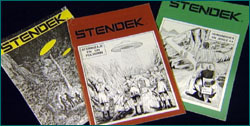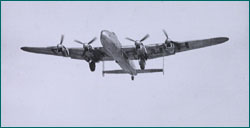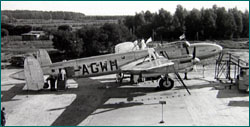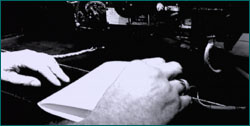 |
 |
|  Inspired by STENDEC: a Spanish UFO
magazine.
Inspired by STENDEC: a Spanish UFO
magazine.
|
Solve the Mystery of STENDEC
STENDEC Theories
On August 2, 1947, Stardust's radio operator sent a final message in
Morse code to the Chilean radio operator then on duty in Santiago. The full
message sent at 17.41 hrs was as follows:
'ETA [estimated time of arrival] Santiago 17.45 hrs STENDEC'
The final apparently unintelligible word "STENDEC" has been a source of
mystery, confusion, and intrigue ever since. So mysterious was the
disappearance of the plane—coupled with its final strange message—that
Stardust became entwined in UFO theories. The word STENDEC was corrupted
into Stendek and became the name of a Spanish UFO magazine.
Now that the plane has been found, we know that it wasn't spirited away by
aliens. However, the mystery of the final radio message remains. What was
experienced radio operator Dennis Harmer trying to say? The official 1947
report into Stardust's disappearance had this to say on the
subject:
The 17.41 signal was received by Santiago only 4 minutes before the ETA. The
Chilean radio operator at Santiago states that the reception of the signal was
loud and clear but that it was given out very fast. Not understanding the word
"STENDEC" he queried it and had the same word repeated by the aircraft twice in
succession. A solution to the word "STENDEC" has not been found. From this time
on nothing further was heard from the aircraft and no contact was made with the
control tower at Santiago. All further calls were unanswered.
Before this message a series of entirely routine messages had been transmitted
by the plane, reporting its position and intended course.
Since the program "Vanished" first aired in Britain, its producers have
received literally hundreds of messages offering explanations of STENDEC. Below
we include a selection of the ideas. Before you have a look at them,
familiarize yourself with Morse code if you're not already familiar
with it. Any explanation for STENDEC depends on an understanding of this
160-year-old technology.
"STENDEC" in Morse code is:
| ... |
/ - |
/ . |
/ -. |
/ -.. |
/ . |
/ -.-. |
| S |
/ T |
/ E |
/ N |
/ D |
/ E |
/ C |
 Is STENDEC an anagram of DESCENT?
Is STENDEC an anagram of DESCENT?
|
|
Anagrams
The Theory
Many people who wrote in pointed out that STENDEC is an anagram of 'descent.'
Variations suggested that the crew might have been suffering from hypoxia (lack
of oxygen), because the Lancastrian was unpressurized and the plane was flying
at 24,000 feet, which might have led the radio operator to scramble the
message. Other explanations for the appearance of an anagram in an otherwise
routine message included a dyslexic radio operator and/or receiver in Santiago,
and playfulness on behalf of Stardust's radio operator.
Discussion
While it's true that the Lancastrian was unpressurized, the crew were all supplied
with oxygen. A faulty oxygen system can't be ruled out but seems unlikely.
Furthermore, while it is relatively easy to imagine STENDEC being scrambled
into descent in English, it is much harder in Morse code.
| -.. |
/ . |
/ ... |
/ -.-. |
/ . |
/ -. |
/ - |
(Descent) |
| ... |
/ - |
/ . |
/ -. |
/ -.. |
/ . |
/ -.-. |
(STENDEC) |
And it's even less likely that the same Morse dyslexia would be repeated three
times.
STENDEC/Stardust
The Theory
The radio operator meant to say 'Stardust.' STENDEC and Stardust have
some similarities in both Morse code and English:
| ... |
/ - |
/ .- |
/ .-. |
/ -.. |
/ ..- |
/ ... |
/ - |
(Stardust) |
| ... |
/ - |
/ . |
/ -. |
/ -.. |
/ . |
/ -.-. |
|
(STENDEC) |
Discussion
They may be similar, but it is still hard to imagine an experienced radio operator
getting his plane's name wrong on three occasions. Furthermore, aircraft were
usually referred to by their registration (in Stardust's case G-AGWH)
rather than the romantic names airlines gave them. And finally, there seems to
be no reason to transmit the plane's name at the end of a routine
message.
|  When he tapped out STENDEC, did the radio operator
mean STARDUST?
When he tapped out STENDEC, did the radio operator
mean STARDUST?
|
Initials
The Theory
Various people came up with intriguing, imaginative, and sometimes amusing messages
based on using STENDEC as a series of initials. Hence we have:
- "Santiago tower message now descending entering cloud" (or "Santiago tower aircraft now descending entering cloud")
- "Stardust tank empty no diesel expected crash"
- "Systems to the end navigation depends entirely on circle" (this correspondent conceded that "the last bit may be a bit muddled")
- "Santiago tower even navigator doesn't exactly know"
Discussion
All these variations seem implausible to a greater or lesser extent. Morse code
experts the producers have consulted believe it is highly unlikely that a
radio operator would resort to convoluted messages based on initials.
 The Morse code may hold the answer as to what
Stardust's radio operator really meant to say.
The Morse code may hold the answer as to what
Stardust's radio operator really meant to say.
|
|
Explanations based in Morse code
The Theory
Perhaps the most plausible explanations we have heard are firmly based in Morse code
and have come from people highly familiar with this method of communication.
Several people have pointed out that the sign-off for a Morse code message is
AR. The Morse for AR is:
which is identical—although with different spacings—to EC:
Similarly, another Morse expert has pointed out that to attract attention it is
common to use the dots and dash for V as a calling-up sign. Again, this is the
same as ST, only with different spacing:
That would leave just "END" sandwiched between a signal attracting attention,
and another signing off.
Another explanation, advanced at the time of the disappearance, was that a
small rearrangement of the dots and dashes—for example, losing the first two
dots—yields ETA LATE, apparently a common method of signalling a late
arrival amongst Royal Air Force radio operators:
| . |
/ - |
/ .- |
/ .-.. |
/ .- |
/ - |
/ . |
(ETA LATE) |
| ... |
/ - |
/ . |
/ -. |
/ -.. |
/ . |
/ -.-. |
(STENDEC) |
Discussion
Why would the operator say "end"? Possibly because he was finishing Morse
transmissions prior to picking up voice communication. Voice communication was
only possible at this time when the aircraft was very close to the airport, and
one pilot and radio operator who flew at this time reports that it was common
to inform the airport that Morse transmissions were closing down. The problem?
Why would the operator use a calling-up sign in the middle of his message?
Similarly, why would an operator say ETA LATE when he had only just confirmed
his time of arrival?
|  What is the true meaning of the word the
Santiago-based radio operator heard three times that August night in 1947? We
may never know.
What is the true meaning of the word the
Santiago-based radio operator heard three times that August night in 1947? We
may never know.
|
Conclusion
Some things can be said with some degree of certainty. It seems clear that STENDEC
is not what the Morse-code message was meant to say. The word is meaningless,
and trying to use it as an acronym or an abbreviation yields little
fruit.
It also seems clear that Stardust's radio operator was not anticipating
a crash, otherwise he would not have repeated the message three times. And why
not use SOS, the internationally accepted distress signal?
Fiddling with Morse code seems to offer the best chance of getting close to an
understanding of the message. But in the absence of a new clue, the truth is we
will never know for sure what that final enigmatic radio message was meant to
mean.
STENDEC Theories
Tapping into Morse Code
1947 Official Accident Report
Readers' Theories
A version of this article originally appeared on the Horizon Web site at
www.bbc.co.uk/science/horizon/vanished_stendec.shtml. Used with permission.
Solve the Mystery of STENDEC |
Mysterious Plane Crashes
Reading the Wreckage |
Inside the Jet Stream |
Resources
Transcript |
Site Map |
Vanished! Home
Editor's Picks |
Previous Sites |
Join Us/E-mail |
TV/Web Schedule
About NOVA |
Teachers |
Site Map |
Shop |
Jobs |
Search |
To print
PBS Online |
NOVA Online |
WGBH
© | Updated January 2001
|
|
|